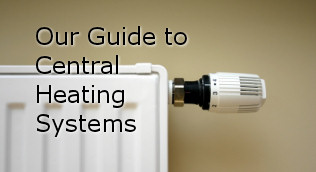Central heating systems | Forced air, hydronic and storage heaters

This is the first in a series of articles dedicated to central heating and the subject of heating your home.
Central heating systems get their name from the fact that only one source of heat is used, although the term "central" is also used loosely to describe other types of system.
In a genuine central heating system the heat is generated in a single boiler (wet system) or furnace (dry system) and then carried to other rooms in the building via a network of pipes or ducts.
Central heating systems get their name from the fact that only one source of heat is used, although the term "central" is also used loosely to describe other types of system.
In a genuine central heating system the heat is generated in a single boiler (wet system) or furnace (dry system) and then carried to other rooms in the building via a network of pipes or ducts.
Types of Central Heating Systems
Advertisements
Genuine Dry (Forced Air) Heating System
This type of heating system typically uses a single large furnace (usually gas-fired) and a network of ducting to transport the heat throughout the building.
To assist the movement of the hot air within modern systems a fan is used to force the warm air to circulate through the ducting.
Each room that is heated by the system has a damper on the duct to control the local temperature.
Genuine Wet (Hydronic) Central Heating System
Hot water is used in this type of heating system in order to provide the heat.
The typical system consists of a single boiler (hence the word central) which feeds a network of pipes and in turn either radiators or convectors.
This is the most common type of central heating found in homes today.
There are two main adaptations of the basic hydronic system; Open-Vented and Sealed.
This type of heating system typically uses a single large furnace (usually gas-fired) and a network of ducting to transport the heat throughout the building.
To assist the movement of the hot air within modern systems a fan is used to force the warm air to circulate through the ducting.
Each room that is heated by the system has a damper on the duct to control the local temperature.
Genuine Wet (Hydronic) Central Heating System
Hot water is used in this type of heating system in order to provide the heat.
The typical system consists of a single boiler (hence the word central) which feeds a network of pipes and in turn either radiators or convectors.
This is the most common type of central heating found in homes today.
Open-vented systems utilise a "feed and expansion" tank (cistern). As the name suggests, the tank is used to feed the supply and to accommodate any water expansion that is generated by the heating process. The "feed and expansion" tank is placed at the highest point in the system (usually the loft).
An Open-vented system typically uses a small-bore two pipe network, where one pipe is used to feed the system and the other allows the cooled water to return to the heat source (boiler).
For more on open-vented, see our guide to Hydronic Open-Vented Heating Systems.
Sealed Systems use an expansion vessel to handle the excess water. The flexible diaphragm within the vessel will give to allow the water to expand. These systems also feature a safety valve, which allows the water to exit the system if the pressure becomes too much.
The system is fed from a filling loop, which has a non-return valve integrated. The non-return valve stops any water that has entered the system from finding its way back into the mains supply. A topping-up bottle is integrated into the system so that the water level can be easily replenished.
Underfloor and Ceiling Heating Systems
Although these are not genuine central heating systems (unless just one boiler is used along with a pipe network), they are often referred to as such.
An underfloor heating system uses either electrical heating elements or piped hot water built in to the floor structure to heat the room.
A ceiling heating system will typically use the same methods for producing heat as underfloor heating (electric elements or hot water).
The heat is generated in the ceiling space and reflected back down into the room by insulation.
Electric Storage Heating Systems
This type of heating system, although not central is often referred to as central heating.
Each heater contains firebricks and these bricks are heated by electric elements at off-peak times. The heater then releases the heat using either simple convection or fans at peak times, or in accordance with the timer.
Advertisements
